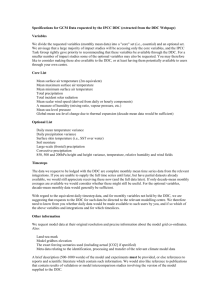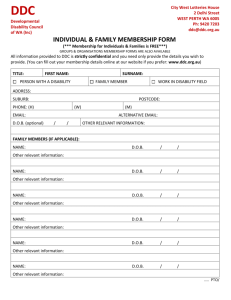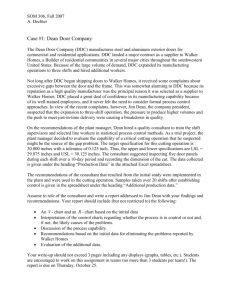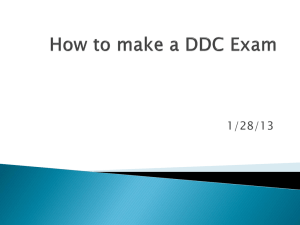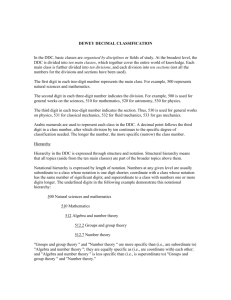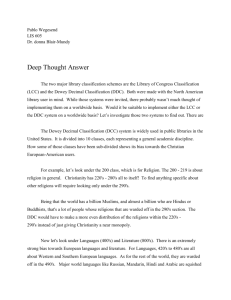Presentation - Faculty of Information
advertisement
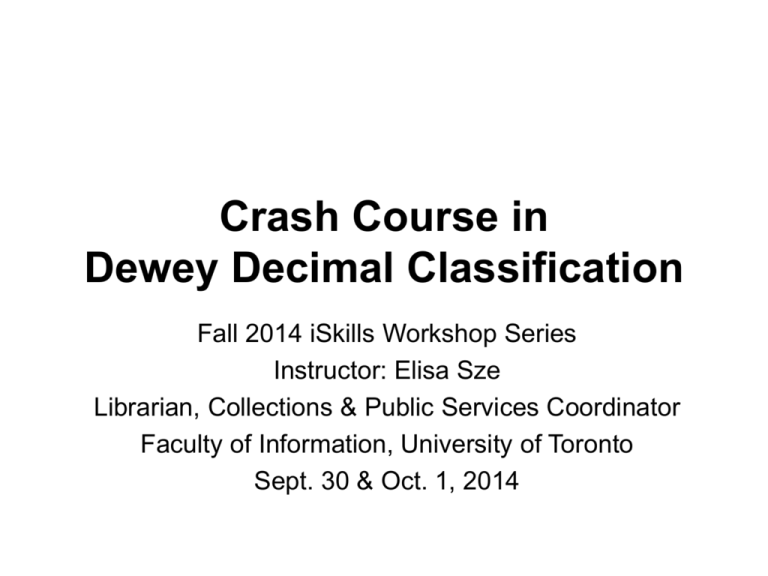
Crash Course in Dewey Decimal Classification Fall 2014 iSkills Workshop Series Instructor: Elisa Sze Librarian, Collections & Public Services Coordinator Faculty of Information, University of Toronto Sept. 30 & Oct. 1, 2014 What is Dewey Decimal Classification? • Method of organizing knowledge, first by discipline, then by subject • Decimals allow the system to be extensible • Notation is based on Arabic numerals, for universality • Analytico-synthetic classification Collocation: bringing together similar works 069 = about museology/ museum science 069 A211 H972 = Cutter notation for the author’s name 069 H972 069 L653 Background Date conceived 30+ languages First published in Who updates it now? Library of Congress Current copyright holder: OCLC 135+ countries Images: DDC 1st ed. title page: https://archive.org/stream/classificationan00dewerich#page/n7/mode/2up Portrait of Melvil Dewey: http://digitalgallery.nypl.org/nypldigital/id?1222486 World map: http://digitalgallery.nypl.org/nypldigital/id?464988 Formats & Editions Print DDC 23 Abridged 15 Online WebDewey WebDewey 23 WebDewey WebDewey 23 look for Abridged Edition 15 The Abridged 15 is guided by the same principles as the full DDC 23. DDC 1 (1876) 000 Bibliography 100 Philosophy 200 Theology 300 Sociology 400 Philology 500 Natural Science 600 Useful Arts 700 Fine Arts 800 Literature 900 History Source: Dewey, M. (1876). A classification and subject index for cataloguing and arranging the books and pamphlets of a library (Amherst, Massachusetts: Forest Press Division, Lake Placid Education Foundation). Page 12. Retrieved at: http://quod.lib.umich.edu.myaccess.library.utoronto. ca/m/moa/aey7382.0001.001/14?page=root;size=1 00;view=image DDC 23 (2011) 000 Computer science, information & general works 100 Philosophy & psychology 200 Religion 300 Social sciences 400 Language 500 Science 600 Technology 700 Arts & recreation 800 Literature 900 History & geography Source: Dewey, M. (2011). Dewey decimal classification and relative index, 23rd edition. J. Mitchell (Ed.). Dublin, OH: OCLC. How to Classify 1. Determine the subject of the work. 2. Determine the DDC notation based on the discipline of the subject. 3. Follow all instructions in the schedule and relevant tables. 4. Keep in mind the rules of DDC. Quick Warm-ups http://dewey.org/webdewey/login/login.html Diseases Linguistics Incunabula Structural Hierarchy Instructions and notes pertaining to one number also apply to the numbers beneath it in the same hierarchy. 700 The Arts contains a scope note “Description, critical appraisal…” The same scope note also applies to: 730 Sculpture 736 Carving 736.4 Wood carving Notational Hierarchy Each number is: • Subordinate to the number that is 1 digit shorter 636.71 Breeds of dogs is subordinate to 636.7 Dogs • Coordinate with numbers that have the same number of significant digits 636.72 Nonsporting dogs is coordinate with 636.73 Working and herding dogs • Superordinate to a number that is 1 digit longer 636.72 Nonsporting dogs is superordinate to 636.728 Poodles Length of Numbers • All numbers must be at least 3 digits long • Some numbers will begin with 0 or 00 001 Knowledge • No periods for 3-digit numbers • Numbers longer than 3 digits have a period inserted between the 3rd and 4th digits 001.1 Intellectual life Number Building • Table 1. Standard Subdivisions can be added to almost any number in the schedule except when instructed otherwise. • Exceptions: - “Do not add” “No number building” Topics listed within “Including…” notes When the topic is already covered by the schedule (avoid redundancies!) Number Building: 025 + T1 Apply the appropriate standard subdivision to the base number 025. Standard Subdivision Dictionary of library operations Journal of library operations A museum of the artifacts of library operations Final Notation Number Building • Tables 2 to 6 can only be added when specifically told to add them. • Other instructions for number building appear in the schedule, when applicable. Number Building: Notation for ROM using 069 + T1 –09 + T2 069.09 Historical, geographic, or biographical treatment of Museology See instructions for: T1 –093 - T1 –099 Look out for… • Discontinued numbers [ ] • Optional numbers ( ) • Tables of preference at the beginning of T1 and throughout the schedule • Footnotes * • Center notes > • Notes – – – – – – – – – Add Build Class elsewhere Class here Comprehensive works Do not use Including See Manual Scope notes Rules for More Complex Classification Rules of DDC Rule of application If a work deals with interrelated subjects in the same discipline, class the work with the subject that is being acted upon. Example Administration 101 for museum professionals “Actor”: Administration Subject that is “acted upon”: Museums Rules of DDC Fuller treatment If a work deals with two or more subjects in the same discipline, class the work with the subject receiving the fuller treatment. Example A book that is mostly about photography, with a bit about painting Subject receiving fuller treatment: Photography Rules of DDC First-of-two rule For two subjects treated equally, class the work with the subject whose number comes first in the DDC schedules. Example A book that is 50% about photography, 50% about painting Subject whose number comes first: Painting Rules of DDC Rule of three If a work covers equally 3 or more subjects that are all subdivisions of a broader subject, class the work in the first higher number that includes all the subjects. Example A book that is equally about mathematics, astronomy, and physics First higher number that includes all the subjects: Science Rules of DDC Rule of zero Keep only as many zeroes as necessary for distinguishing a standard subdivision from the regular numbers in the schedule. Example 700 The arts (fine, decorative, literary, performing, and recreational) 700.1 Philosophy of art 701 Philosophy of fine and decorative arts 720 Architecture 720.1 Philosophy of architecture Rules of DDC Interdisciplinary numbers If the work treats the subject from multiple disciplines, and an interdisciplinary number is provided in the schedules or Relative Index, use the interdisciplinary number when applicable. Example 001.9 Controversial knowledge “Class here interdisciplinary works on controversial knowledge, parapsychology, occultism.” Rules of DDC • Table of Last Resort • Intention of the author Your Turn • Work in pairs or groups of 3. • Determine the notation for each topic. • For topics where more than 1 notation is possible, explain your choice of notation. • For notations that you build, explain the instructions that you used. Freedom of information Semantic Web A museum collection of historical ball gowns Artistic depictions of the natural sciences For additional practice with DDC, try the exercises in your handout. Evaluations http://current.ischool.utoronto.ca/ classificationwithdewey/fall2014


